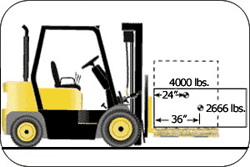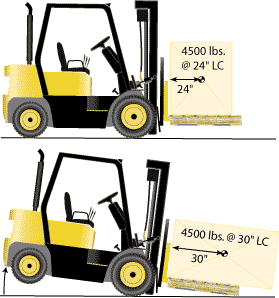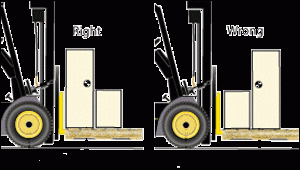You have no items in your shopping cart.
Load Handling And Composition On A Forklift – Part I: Weight, Size, And Position

(Graphic courtesy of OSHA)
Stability of the forklift is essential. If it is not stable as it carries a load, then an accident is waiting to happen.
Things to consider when loading a forklift include:
• Weight, size and position
• Safe load capacity
• Maximum load moment
• Balance
• Stability
Weight, size, and position

Rectangular boxes should be positioned width-wise to assure that the load is within the capacity of the lift. (Graphic courtesy of OSHA)
The standard load center of the lift is traditionally 24-inches. So if the forklift’s capacity is based on the load being a cube with the weight evenly distributed with the center of gravity being exactly in the center of that cube, then the horizontal distance from the center of the load to the vertical part of the forks should be 24-inches.
As the center of gravity for the load moves forward, the lifting capacity for the forklift decreases.
Of course, most loads are not perfectly shaped cubes with the center of gravity exactly in the middle of the cube. Loads are often irregular in shape, unbalanced in weight distribution, and are not centered on the forks of the lift. The result is that the capacity of the forklift may be reduced.
Therefore, arranging the load properly is essential for safety. When arranging a load on a forklift, you should be aware of potential hazards, which include tip over, loss of steering control due to shifting of too much weight forward causing the rear wheels to raise, falling load, and collision.
Taking all into consideration, the requirements and suggestions on loading the lift include:

The heaviest weight should be loaded as close to the mast as possible. (Graphic courtesy of OSHA)
• Never exceed the capacity of the lift, which is marked on the data plate or nameplate of the lift. If the load is over-sized, irregularly shaped or incorrectly loaded, the actual load center distance could exceed the stated load center distance, which exceeds the lifts capacity.
• Always minimize the distance from the front wheels to the load center. So when loading a large rectangular box, place it width-wise across the forks of the lift. Placing a large rectangular load lengthwise can result in the load center shifting forward away from the front wheels, exceeding the lift’s capacity and raising the rear wheels of the lift off the ground.
• Place the load as close to the front wheels as possible to minimize the load’s center distance with the heavier part toward the mast.
• Position the load so that it shortens the load center distance.
(Source and: osha.gov)
